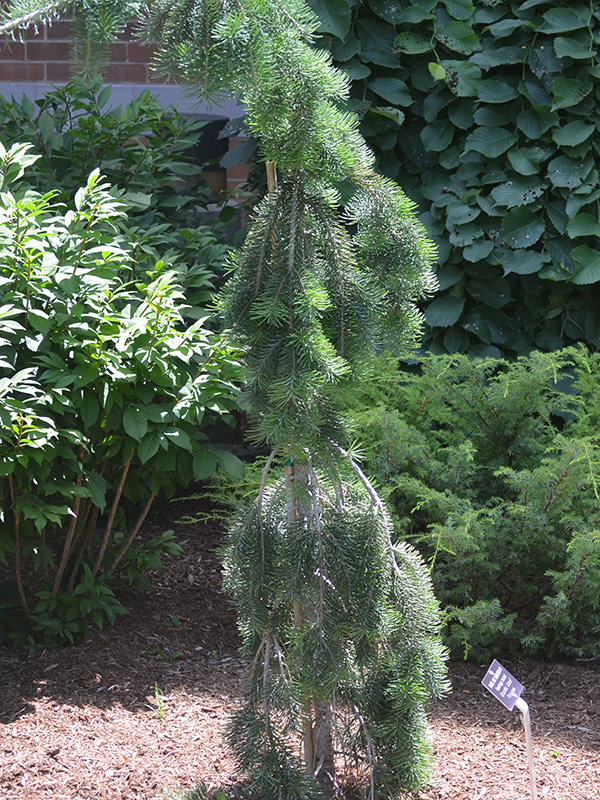
Woody > Pseudotsuga > Pseudotsuga menziesii > Pseudotsuga menziesii
Pseudotsuga menziesii
Douglas Fir
Origin: Native to North-America. Douglas Fir was once an important timber tree in the United States. Still a mystery to foresters and taxonomists, Pseudotsuga menziesii has been reclassified multiple times and continues to be a marvel of botanical evolution. Introduced by Victorian plant collector David Douglas who was employed by the Horticultural Society of London (later to become the Royal Horticultural Society) in the 1920’s. Douglas was killed under suspicious circumstances on his return from the Pacific North-West via Hawaii in 1834 at the age of 35. In Alberta, Canada the species is found on the east slopes of the Rocky Mountains from Jasper Park to Waterton and through the Porcupine Hills.
Mike's
Opinion


"
An incarnation of the Pacific North-west, Douglas Fir captures the beauty of British Columbia while providing a native and attractive specimen in a garden. A classic tree that is seldom used it is a great substitute for ordinary spruce.
Michael Pascoe, NDP., ODH., CLT., MSc. (Plant Conservation)
"
| Family |
| Pinaceae |
| Genus |
| Pseudotsuga |
| Species |
| menziesii |
| Category |
| Woody |
| Type |
| Tree (evergreen) |
| Pronunciation |
| USDA Hardiness Zone |
| 4 - 6 |
| Canadian Hardiness Zone |
| 2a - 6a |
| RHS Hardiness Zone |
| H6 - H7 |
| Temperature (°C) |
| -35 -(-18) |
| Temperature (°F) |
| -30 - 0 |
| Height |
| 12 - 30 m |
| Spread |
| 4 - 6 m |
Photographs
Description and Growing Information
Flowering Period
| Landscape |
| An attractive native forest tree, Pseudotsuga menziesii adds a natural, soft feeling to a landscape. Suitable for massing but does not perform well as windbreaks or understory plantings and has limited pollution tolerance. |
| Cultivation |
| Prefers full sun and neutral or slightly acid, moist, well drained soils. |
| Shape |
| Pyramidal growth habit at a young age later developing into an irregular crown. |
| Growth |
| Medium |
| ID Characteristic |
| Roughly pyramidal in shape, crimson flowers and smooth bark at a young age, light brown and reddish ridged bark in later years. Cones that are up to 10 cm long with bracts that extend beyond scales. |
| Pests |
| Susceptible to Douglas Fir bark beetle, scales, aphids, pine butterfly, spruce budworm, multiple species of canker causing fungi as well as needle and leaf and twig blight. |
| Habitat |
| Rocky Mountains and Pacific Coast from British Columbia to Mexico. |
| Bark/Stem Description |
| Trunk is smooth at a young age developing thick reddish brown ridges as the tree matures, the bark can be up to 10 - 15 cm thick and deeply fissured on old trees. |
| Flower/Leaf Bud Description |
| 5-75 mm long, dark brown, ovoid-conical, apex pointed with resinous bases. |
| Leaf Description |
| 2.5-3.5 mm long pectinate shape in v-shaped arrangements. Colour varies from bright, blue, yellow or faded green shades depending on the seed source and variety. |
| Flower Description |
| Monoecious, crimson coloured three pointed bracts. Male flowers are axillary and pendulous while females are terminal. Blooms January to March. |
| Fruit Description |
| 7.5-10 cm long by 3.5-5 cm wide pendulous cones with oval-ovoid three-pronged bracts protruding from cone scales. The seeds are broadly winged. |
| Colour Description |
| Greyish brown bark turning red with age. Branchlets are light brown or grey with varying shades of green leaves. Chestnut brown buds and crimson flowers. |
| Texture Description |
| Medium. |
| Notable Specimens |
| “The Red Creek Fir Giant” located in Port Renfrew on the southern tip of Vancouver Island, British Columbia, Canada is the world’s largest Pseudotsuga menziesii specimen at a height of 74 m. |
| Propagation |
| Easily propagated through seeding, requiring little or no pre-treatment depending on source. Intense stress is put on plant if propagated by cutting. High success of transplanting when tree is 10 years old or less. |
| Ethnobotanical Uses (Disclaimer) |
| The wood may be used for building construction. Other uses include railway ties, boxes and crates as well as Christmas trees. |




